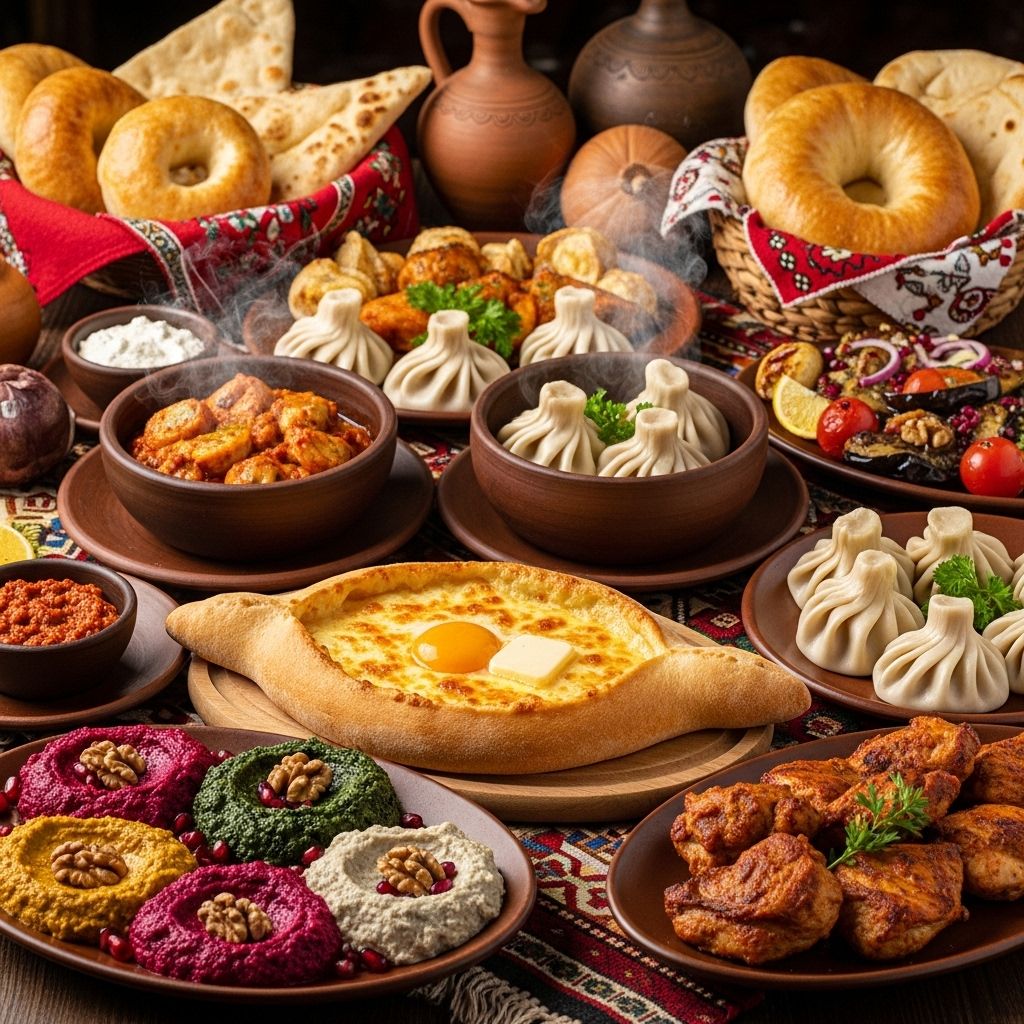Georgian Food: Essential Dishes And Rich Culinary Traditions
Ancient recipes and communal feasts unite generations around one unforgettable table.

A Journey Through Georgian Food: Essential Dishes and Culinary Traditions
At the crossroads of Europe and Asia, Georgia has nurtured a cuisine as vibrant as its centuries-old culture. Georgian food is famed for rich flavors, inventive use of spices, and communal dining. This guide explores the building blocks of Georgian cuisine, its everyday breads and cheeses, and the must-try dishes that reveal why this country is a hidden culinary gem.
The Rich Tapestry of Georgian Cuisine
Georgian cuisine traces its roots through Silk Road influences, weaving together Persian, Mediterranean, Middle Eastern, and Slavic techniques. Yet, it retains a wholly unique personality marked by bold seasoning, recklessly generous amounts of fresh herbs, and the persistent presence of walnuts in sauces and salads. Each region in Georgia boasts signature foods, reflecting local climates and centuries of trade and migration.
- Walnuts, coriander, garlic, fenugreek, tarragon, and blue fenugreek are core flavorings.
- Meat (especially pork, chicken, beef, and lamb) features in hearty main courses.
- Vegetables, beans, and grains underpin many vegetarian dishes.
- Cheese and bread are everyday staples—the foundation of nearly every meal.
- Wine is omnipresent, both at the table and in local culture, honoring Georgia’s 8,000-year-old tradition of winemaking.
Georgian Bread and Cheese: Foundations of the Table
No meal in Georgia begins without puri (bread) and cheese. These humble staples take on myriad forms, reflective of region and tradition.
Kinds of Georgian Bread
- Tone Puri: Oval-shaped loaves baked in a tandoor-style clay oven, often torn by hand at mealtime.
- Shotis Puri: Canoe-shaped and crunchy, also clay-oven baked.
- Khachapuri: Georgia’s most famous bread, featuring melted cheese inside, with endless regional varieties.
Essential Georgian Cheeses
- Suluguni: A brined, slightly sour cheese that melts beautifully—think of it as the mozzarella of Georgia.
- Imeruli: Milder and firmer, primarily used in Imeretian dishes.
- Guda: Traditionally aged in sheepskin, used on festive occasions.
Khachapuri: Cheese-Filled Perfection
Khachapuri is arguably Georgia’s national dish and culinary symbol. It consists of a simple bread filled with cheese, but regional twists make it endlessly fascinating.
| Type | Description |
|---|---|
| Imeruli | Round, flat bread filled with mild Imeruli cheese—simple and classic. |
| Adjaruli | Boat-shaped, filled with molten suluguni cheese, topped with a fresh egg and knob of butter. Diners mix the egg and butter tableside for a luscious mess. |
| Megruli | Like Imeruli, but with an added cheese layer on top. |
Khachapuri can be breakfast, snack, or centerpiece of a festive meal. Every bakery in Georgia boasts their own secret cheese blend or dough technique.
Khinkali: The Quintessential Georgian Dumpling
Khinkali are large soup dumplings filled with a juicy mixture of seasoned minced meat (often lamb, beef, or pork), or sometimes mushrooms or cheese. Originating in Georgia’s mountainous north, khinkali have become a symbol of Georgian comfort food and conviviality.
- Khinkali are eaten without cutlery—diners grasp the doughy cap, bite in, and slurp the flavorful broth before devouring the rest. The top knob of dough is traditionally left uneaten.
- Common fillings include meat, herbs, mushrooms, cheese, or potatoes.
- Regional variants abound—beef and pork are common in the east, while lamb rules in the mountains.
Essential Georgian Dishes Beyond Bread and Dumplings
Mtsvadi: Georgian Barbecue
Mtsvadi is Georgia’s answer to the kebab: skewered cubes of pork, beef, or lamb, marinated and roasted over open flames. Traditionally, mtsvadi is served sizzling hot, often with a scattering of raw onions and pomegranate juice. It’s a staple at gatherings and frequently enjoyed outdoors.
Lobio: Hearty Stewed Beans
Lobio is a rustic, deeply satisfying bean dish, popular everywhere in Georgia. Beans are slow-cooked with onions, garlic, coriander, cilantro, and sometimes walnuts or chili. Served in a clay pot, lobio can be thick and hearty or soupy and delicate. Pickled vegetables and cornbread (mchadi) are common sides.
Kharcho: Spiced Beef and Rice Soup
Kharcho blends beef, rice, tomatoes, cherry plum sauce (tkemali), and ground walnuts. The soup is rich, thick, tangy, and notably perfumed with fresh herbs and spices. It’s warming comfort food when the Caucasus nights grow cold.
Pkhali: Vegetable and Walnut Pâtés
Pkhali showcases Georgia’s virtuoso use of walnuts. These colorful spreads are made by finely chopping or blending cooked vegetables (beet greens, spinach, eggplant, or beans) with ground walnuts, garlic, vinegar, and herbs. Served as appetizers, pkhali are adorned with bright pomegranate seeds and bursts of coriander.
Ajapsandali: Summer Vegetable Stew
Ajapsandali is Georgia’s go-to vegetarian meal—a medley of eggplant, tomatoes, peppers, potatoes, onions, and herbs, gently cooked until all flavors meld beautifully. This stew is popular in summer and showcases the bounty of local gardens.
Chakapuli: Aromatic Lamb or Veal Stew
Chakapuli is a tangy, springtime stew of lamb or veal cooked with tarragon, green plums (or tkemali sauce), white wine, and abundant dill. The result is refreshing and deeply flavorful—a nod to Georgia’s green hillsides and spring markets.
Kababi & Kupati: Sausages and Chargrilled Meat
- Kababi: Spiced minced meat (usually beef or lamb) wrapped around skewers and grilled; often served with pickled onions or pomegranate seeds.
- Kupati: Robust sausages, usually made with pork and flavored with plenty of garlic and spices—Svanetian versions may have added herbs or blood.
Chakhokhbili: Georgian Chicken Stew
Chakhokhbili is a homestyle stew of chicken simmered with onions, tomatoes, red peppers, and fragrant herbs. Once a dish made with pheasant, it now relies on chicken for daily fare.
Satsivi: Poultry in Walnut Sauce
Satsivi is chicken or turkey stewed in a vivid, garlicky walnut sauce, thickened with vinegar and cinnamon. Traditionally served cold, satsivi graces nearly every Georgian holiday table.
Kuchmachi: Spiced Offal with Walnuts and Pomegranate
Kuchmachi is a dish for the adventurous: chicken livers, hearts, and gizzards (or similar cuts of pork or beef) sauteed with walnuts and pomegranate seeds. It’s earthy, rich, and always heady with aromatic herbs.
Salads, Pickles, and Cold Dishes
Georgian tables groan with vibrant salads and pickled vegetables, all designed to spark the appetite and pair with heavier fare.
- Simple salads: Chopped tomatoes, cucumbers, onions, frequently scented with herbs and splashed with walnut oil or vinegar.
- Jonjoli: Pickled blossoms from a local shrub, unique to Georgian cuisine, with a tart, lemony punch.
Spiced Sauces and Condiments
- Tkemali: Tart plum sauce, a table condiment akin to ketchup, served with grilled meats, khinkali, and bread.
- Adjika: A fiery red or green paste of chilies, garlic, herbs, and spices—Georgia’s answer to harissa or sambal.
- Bazhe: Walnut-garlic sauce, sometimes seasoned with vinegar and served with poached chicken or vegetables.
Regional Specialties Worth Seeking Out
- Kubdari: Savory bread from mountainous Svaneti, stuffed with seasoned lamb or beef.
- Kharsho: Beef and walnut soup with Georgian spices, common in Samegrelo.
- Tabaka: Pan-fried or pressed chicken, often smothered in garlic or adjika spice rub.
- Khashlama: Slow-boiled beef or lamb with minimal seasoning, enjoyed for breakfast or on feasting days.
- Lori: Smoked pork from the Racha region.
Dining Traditions: Supras, Toasts, and Hospitality
A true Georgian meal is about more than food—it’s about the spirit of hospitality and communal gathering known as the supra. Guests are lavished with food and wine, and meals are orchestrated by the tamada (toastmaster), who leads a ritual of poetic toasts to family, ancestors, beauty, and peace. Feasts are festive and often last for hours, marked by laughter, singing, and countless dishes shared by all.
The Role of Wine in Georgian Cuisine
Georgia is often called the “cradle of wine.” Ancient winemaking is entwined with dining: well-structured, acidic whites and earthy, robust reds are crafted in clay qvevri (amphorae). Wine is more than a drink—it is a vehicle for connection, tradition, and ritual. Red Saperavi and white Rkatsiteli are two famous indigenous grapes often enjoyed at table.
Frequently Asked Questions About Georgian Food
Q: Is Georgian cuisine spicy?
A: While some dishes such as adjika and certain stews carry a spicy kick, most Georgian food is flavorful rather than fiery, relying on herbs and spices for complexity rather than heat.
Q: What is the most famous Georgian dish?
A: Khachapuri, the cheese-filled bread, is undoubtedly the national icon and a must-try for any visitor.
Q: Can vegetarians eat well in Georgia?
A: Absolutely. Many Georgian staples are vegetarian or vegan, such as lobio, pkhali, ajapsandali, and an impressive array of breads and salads.
Q: How is khinkali different from soup dumplings elsewhere?
A: Georgian khinkali are typically larger than Asian dumplings, made with wheat dough, and filled with a distinctive spiced meat and broth mix. The ritual of eating—grabbing by the stem, biting, and slurping the broth—is unique.
Q: What should I drink with a Georgian meal?
A: Georgian wine is the classic pairing. If not wine, try chacha (grape brandy) or local mineral waters.
Tips for Exploring Georgian Cuisine
- Always accept second (or third!) helpings at a Georgian table—they’re a sign of hospitality.
- Sample regional specialties as you travel; each area has distinctive breads, cheeses, and stews.
- Don’t skip the sauces: tkemali and adjika add dimension to even the simplest dishes.
- Bread and cheese are never just side dishes—they are essential parts of the meal.
Conclusion: Why Georgian Food Captivates
Georgia’s food is a mirror of its generous culture: warm, communal, inventive, and impossible to experience in isolation. Whether you’re savoring molten khachapuri, spicy meat-laden mtsvadi, or aromatic pkhali, every meal is an invitation to share stories, honor tradition, and join a table that always has room for one more.
References
- https://en.wikipedia.org/wiki/Georgian_cuisine
- https://www.journalofnomads.com/georgian-food-georgian-cuisine/
- https://adventurousmiriam.com/traditional-georgian-food/
- https://www.askanelirestaurantfl.com/post/discover-the-rich-flavors-of-georgian-cuisine
- https://www.passportsandpreemies.com/georgian-foods/
Read full bio of Shinta












